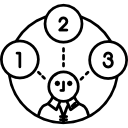Programming: Difference between revisions
Mr. MacKenty (talk | contribs) |
Mr. MacKenty (talk | contribs) No edit summary |
||
| (One intermediate revision by the same user not shown) | |||
| Line 15: | Line 15: | ||
* [[What is a programming language?]] | * [[What is a programming language?]] | ||
* [[Compiler]] | * [[Compiler]] | ||
| Line 57: | Line 54: | ||
* [[Algorithms]] | * [[Algorithms]] | ||
* [[Functions]] | * [[Functions]] | ||
== Other important ideas in programming == | == Other important ideas in programming == | ||
| Line 63: | Line 61: | ||
* [[Design Patterns]] | * [[Design Patterns]] | ||
* [[Object-Oriented Programming]] | * [[Object-Oriented Programming]] | ||
* [[Working with files]] | |||
== References == | == References == | ||
Revision as of 11:10, 23 January 2019
This is one of the most important ideas you can remember:
Decompose a problem into smaller parts, diagram a problem. Learn to think sequentially

Introduction to programming[edit]
Programming is the issuing of instructions to a computer. You must learn how to issue instructions to a computer.
Basic understanding[edit]
Primitive data types[edit]
In computer science and computer programming, a data type or simply type is a classification of data which tells the compiler or interpreter how the programmer intends to use the data. Most programming languages support various types of data, for example: real, integer or Boolean.[2]
The list below describes some of the more common primitive data types
Common data structures[edit]
Control Flow[edit]
In computer science, control flow (or flow of control) is the order in which individual statements, instructions or function calls of an imperative program are executed or evaluated. [3]
Basic program organization[edit]